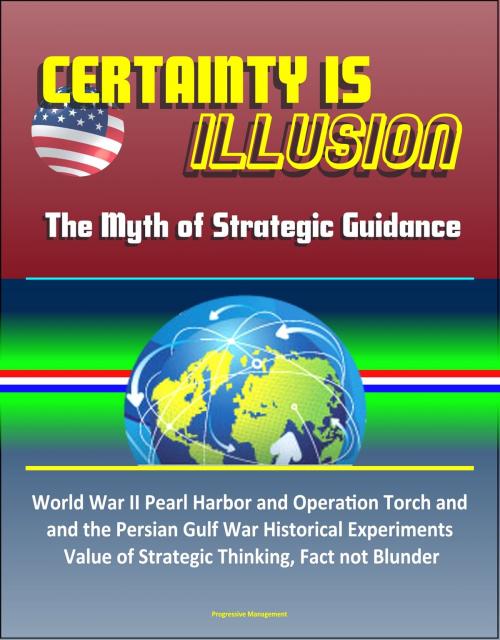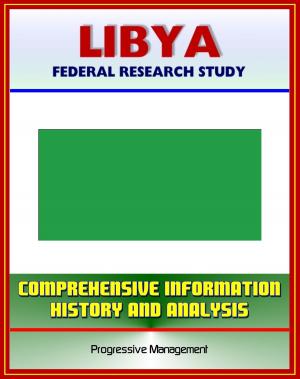Certainty is Illusion: The Myth of Strategic Guidance - World War II Pearl Harbor and Operation Torch and the Persian Gulf War Historical Experiments, Value of Strategic Thinking, Fact not Blunder
Nonfiction, History, Military, Strategy, World War II| Author: | Progressive Management | ISBN: | 9781370215928 |
| Publisher: | Progressive Management | Publication: | February 25, 2017 |
| Imprint: | Smashwords Edition | Language: | English |
| Author: | Progressive Management |
| ISBN: | 9781370215928 |
| Publisher: | Progressive Management |
| Publication: | February 25, 2017 |
| Imprint: | Smashwords Edition |
| Language: | English |
This excellent report has been professionally converted for accurate flowing-text e-book format reproduction. It is axiomatic to military officers that civilian leaders will provide clearly defined, achievable, ends-oriented strategic guidance to inform military planning, springing from a completed strategy to achieve policy goals. This model of the strategic guidance process forms a strategic guidance mythos, reinforced by Samuel Huntington's model of objective civilian control of the military and the Weinberger-Powell doctrine for the use of force. It is further codified in joint doctrine. The mythos is normative, implying successful military operations depend on the clarity of strategic guidance. It includes World War II and the 1991 Gulf War as exemplars of such strategic clarity. Unfortunately, analysis of these two cases reveals something very different: the mythos is an ahistorical myth.
Instead of the clear guidance of the mythos, the guidance processes from World War II (from Pearl Harbor to Operation Torch, specifically) and the Gulf War demonstrate a very different relationship between strategic guidance and military planning. In reality, guidance was more like general principles governing operations than clear objectives. It impacted ways and means, instead of only providing ends. Rather than flowing from a completed strategy, it emerged through a continuous conversation, informed by military planning as much as it guided that planning. These characteristics describe guidance as fact, rather than guidance as an unrealistic ideal. Accepting this fact would support better methods of military planning and better patterns of strategic thought. Such strategic thinking must replace the military's dependence on an unrealistic myth of strategic guidance.
The Standard for Strategic Guidance: the Guidance Mythos * Historical Experiments: Evaluating the Mythos * Experiment #1: Operation Torch * Experiment #2: The Persian Gulf War * Experimental Results * Strategic Principles not Strategic Objectives * Strategy as Discourse * Implications * Fact not Blunder * Strategic Thinking Instead of Strategic Guidance
This excellent report has been professionally converted for accurate flowing-text e-book format reproduction. It is axiomatic to military officers that civilian leaders will provide clearly defined, achievable, ends-oriented strategic guidance to inform military planning, springing from a completed strategy to achieve policy goals. This model of the strategic guidance process forms a strategic guidance mythos, reinforced by Samuel Huntington's model of objective civilian control of the military and the Weinberger-Powell doctrine for the use of force. It is further codified in joint doctrine. The mythos is normative, implying successful military operations depend on the clarity of strategic guidance. It includes World War II and the 1991 Gulf War as exemplars of such strategic clarity. Unfortunately, analysis of these two cases reveals something very different: the mythos is an ahistorical myth.
Instead of the clear guidance of the mythos, the guidance processes from World War II (from Pearl Harbor to Operation Torch, specifically) and the Gulf War demonstrate a very different relationship between strategic guidance and military planning. In reality, guidance was more like general principles governing operations than clear objectives. It impacted ways and means, instead of only providing ends. Rather than flowing from a completed strategy, it emerged through a continuous conversation, informed by military planning as much as it guided that planning. These characteristics describe guidance as fact, rather than guidance as an unrealistic ideal. Accepting this fact would support better methods of military planning and better patterns of strategic thought. Such strategic thinking must replace the military's dependence on an unrealistic myth of strategic guidance.
The Standard for Strategic Guidance: the Guidance Mythos * Historical Experiments: Evaluating the Mythos * Experiment #1: Operation Torch * Experiment #2: The Persian Gulf War * Experimental Results * Strategic Principles not Strategic Objectives * Strategy as Discourse * Implications * Fact not Blunder * Strategic Thinking Instead of Strategic Guidance















